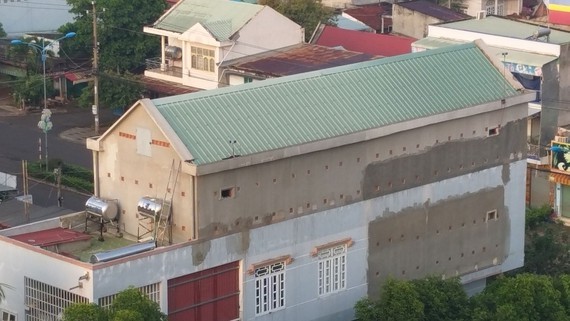
A booming business
Farming swiftlets, or chim yến, has become more and more popular among residents in Tay Ninh in recent years. Authorities in June 2020 reported up to 231 swiftlet homes in the region compared to a mere 17 in 2017, but said there could be many more unaccounted for, including ones owned by local officials.
People also find lucrative deals in providing related service such as bird farm construction and selling tools and equipment.
Mrs. My, a farmer in Duong Minh Chau District, said she knew nothing about swiftlet farming but immediately let her son use her land to build a bird farm when the ‘gold rush’ hit. “I don’t know anything about techniques or even how much it earns, but others are doing it so I told my children to take care of everything”, she said.
As of the end of May 2020, there are a total of 495 swiftlet homes in Binh Duong Province, housing nearly 532,000 swiftlets and yielding 2 tons of product each year, said its Department of Agriculture and Rural Development. There was also 5-time increase in the number of facilities and a 3-time increase in total area compared to 2016. Despite this rapid growth, almost all of the facilities are family-sized farms with no business license, making it difficult for hygiene and disease control.
In Binh Phuoc province, there are currently 300 households farming swiftlets compared to only 100 in 2014. Le Thanh Phuoc, a swiftlet farmer in Phuoc Long town, said a single kilogram of bird nests is worth VND35 million (about US$1,540).
Many people are willing to invest billions of Dong into this potentially short-lived practice, but not everyone comes out a millionaire. Some fail to attract the birds long enough for them to build nests, or even at all.
A staff member of Asiannest, a local bird nest products and service provider, said that the most successful swiftlet farms should have well-placed and well-adjusted sound systems, perfect moisture, and a good hygiene control system.
The price of a fully built swiftlet house ranges from VND760 million-3 billion (about US$32,000-129,000), depending on the surface area, number of floors and the equipment used.
Moving farms out of residential areas
People living near bird farms in Dong Xoai City have filed multiple complaints regarding constant noises from sound systems used to lure in the birds, as well as risks of disease from bird droppings and feathers.
Only 2 active facilities in Tay Ninh Province have permission to farm bird nests, while the rest continue the practice without any business license or health and safety certification. Some people apply for construction permits for their houses but use the opportunity to build swiftlet farms.
In response to this, the People’s Committee of Tay Ninh Province on November 11, 2019 issued Directive No. 09 on enforcing the management of bird nest farming in the province. Bird nest farmers in the area are being instructed on completing necessary paperwork, and face the risk of being fined if they fail to comply.
In Binh Duong province, the Department of Agriculture and Rural Development has prepared short-term regulations on the management of swiftlet farming in the area, expected to be approved by the provincial People’s Council at the end of 2020.
























